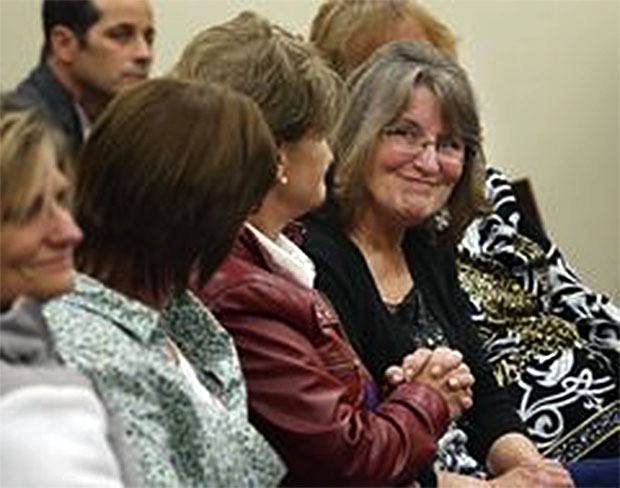EVERETT — Justice found Patti Berry of Arlington on Oct. 20, more than 19 years after she was taken from her family.
Danny Ross Giles, 46, was convicted of first-degree murder in the “cold case” killing. The longtime sex offender was linked to Berry’s death by DNA tests and the skein of lies he spun after being confronted by detectives in 2011.
Berry’s family filled the second row of the courtroom Oct. 20. They gasped and hugged when the verdict was announced.
“Thank you, Jesus,” one said. Nancy Stensrud, Berry’s mother, wept with relief.
The mystery surrounding Berry’s killing was solved by a special team of detectives that Stensrud had lobbied the Snohomish County Sheriff’s Office to create so investigations would continue in unsolved murders gone cold for lack of clues.
The jury listened to nearly three weeks of testimony and began deliberating late Oct. 16.
The jury came into the courtroom at noon Oct. 20. Superior Court Judge Bruce Weiss glanced at the verdict forms and then asked Giles and his attorneys to rise.
Giles didn’t look at the jury. His attorney, Linda Coburn, held her head in her hands. Longtime public defender Neal Friedman studied jurors as they individually affirmed that they believe Giles is guilty of murdering Berry.
Coburn later wrapped an arm around Giles’ back.
“We truly believe Dan is not guilty of this, and we’re disappointed the jury found him guilty. It’s not over,” Friedman said later.
Under state guidelines, Giles faces a minimum 22 years behind bars at his Nov. 5 sentencing. A much longer prison term is likely, however, because of his criminal history. Giles has been cycling in and out of prison all of his adult life, starting with a rape conviction in 1987.
At trial, Giles’ attorneys did their best to convince jurors that the evidence was unreliable and that the investigation had suffered from detectives’ tunnel vision, zeroing in on their client prematurely.
“What a relief!” cold-case detective Jim Scharf said of the verdict. Scharf breathed life back into the case when he submitted the steering wheel from Berry’s blood-stained car for DNA testing.
Evidence convinced investigators that the killer not only attacked Berry in her car, but also likely drove the vehicle to dump her body in a wooded area behind the Everett Mall.
In 2004, forensic testing using techniques that weren’t available in 1995, found on the steering wheel a mix of DNA from Berry and a man. Scharf said that discovery convinced him one day Berry’s killer would be found.
“Before that, this was one of a number of cold cases that I didn’t think had much of a chance of getting resolved,” he said.
Four years later, in 2008, forensic scientists at the state’s crime lab said Giles was the man who left behind DNA on the steering wheel. The odds of a random match were calculated at 1 in 580 million.
Scharf and another detective confronted Giles in 2011. Giles told a series of easily refuted lies about the jobs he’d held and the places he was known to frequent. Detectives believed he was trying to distance himself from places connected to Berry’s killing. At the same time, Giles appeared to know a great deal about the case, including that Scharf was the lead detective.
“His distancing himself from everything, I think, gave us a lot more hope that we could get a conviction,” Scharf said.
Deputy prosecutors Craig Matheson and Bob Langbehn said they were pleased for Berry’s family.
Matheson said he believed the jury listened carefully and reached the proper decision, but it wasn’t an easy case.
“Obviously, there is a reason this didn’t get solved for nineteen years,” he said.
Giles was not a suspect until 2008 when the DNA link was made. By the time trial approached, additional testing had turned up DNA consistent with his profile on the cuffs of the jeans Berry was wearing when she was killed, and on the driver’s seat headrest from her car. Jurors were told those were traces left by the killer when he put Berry’s body into the backseat, and when he pulled off her pants before dumping her in the woods.
Further testing also tied Giles to the 1995 disappearance and presumed death of Tracey Brazzel, who dropped from sight a few months prior to Berry’s killing. Giles’ DNA allegedly turned up on Brazzel’s car, too. He was charged in 2012 with murder in that case as well. Trial in the Brazzel killing is scheduled for early in November.
As the lawyers waited to speak with jurors, Matheson shook Friedman’s hand. The two veteran attorneys said they needed to talk about the upcoming Brazzel trial and whether the timetable is realistic.
“You know what we want,” Matheson said. Brazzel’s body has never been located. Friedman shook his head. “He’s never going to give it to us,” Matheson said of Giles.
Berry was a single mom who supported herself and her daughter, then 2, by dancing nude at Honey’s, a nightclub that used to be located along Highway 99 south of Everett. She disappeared July 31, 1995, after working her shift.
Her family searched for her, and after her body was found never wavered in urging police and prosecutors to keep pressing for answers.
On Monday, Stensrud brought to court with her the 1999 report she and the families of other murder victims had prepared about “cold case” squads, and the good that they do. The report was part of the pitch they made to convince county officials to set aside money to start the team.
Only when killers are put behind bars will families have the chance to properly grieve, Stensrud wrote at the time.
“What I want most of all is to one day spend some time at the cemetery, (to) tell Patti that we never gave up, and that my love for her kept me going. Only then can I say my final ‘goodbye’ and start to rebuild my life,” she wrote.
Stensrud said that soon, she and others in her family will make that visit — something they’ve been waiting on for nearly 20 years.








